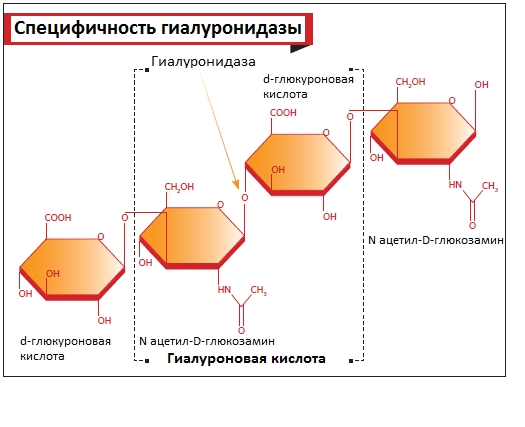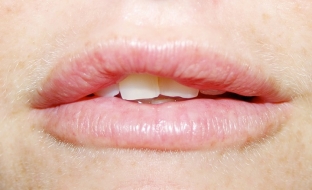Fillers of hyaluronic acid thickened with a cross-linked polymer are widely used in aesthetic medicine. Hyaluronic acid is considered a safe filler, but despite this, it can cause side effects, including overcorrection, infection and granuloma.
To eliminate these effects, hyaluronidase is used, which also reduces the risk of skin necrosis. The article provides detailed information about each of these side effects and how to eliminate them with hyaluronidase.
How hyaluronidase helps to cope with complications after the introduction of hyaluronic acid
Hyaluronidase is a natural enzyme that breaks down hyaluronic acid polymers in a specific way. In the past, it has been widely used to combat cellulite fibrosis, and more recently – to destroy excess hyaluronic acid fillers or granulomas.
Another function is related to improving the viscous properties of various secretions, for example, hyaluronidase helps sperm to penetrate the egg. Some cancer cells also use hyaluronidase to help penetrate tissues. Some animals pass it along with the poison to increase the diffusion of the toxins.
Hyaluronidase is able to break down the long polymer of hyaluronic acid and turn it into an oligomer that will no longer be considered a foreign body for the immune system. The activity of the enzyme is very specific, it produces the hydrolysis of the bond between N-acetyl-D-glucosamine and D-glucuronic acid.
Therefore, hyaluronidase cannot help in cases of overcorrection performed with other types of fillers (e.g. polylactic acid, collagen, silicone) or in cases of immune reactions to these drugs
Hyaluronidase is typically presented in lyophilized form, 1500 units, to be dissolved in sterile saline. The solution does not contain preservatives and should be used immediately after preparation.
The use of hyaluronidase in cosmetology is simple and consists in injecting a sterile solution of hyaluronidase powder exactly into the problem area.
An allergy test must be performed before each injection, since hyaluronidase – it is an enzyme, an exogenous protein. The results of such a procedure are significant and noticeable immediately.
So, let's look at the following topics in this article:
- how hyaluronidase can help treat granuloma;
- use of hyaluronidase for the treatment of postoperative fibrosis;
- hyaluronidase to eliminate excess hyaluronic acid fillers;
- injection of hyaluronidase in case of the Tendal effect;
- tests to detect an allergic reaction to hyaluronidase.
How hyaluronidase can help treat granuloma
Hyaluronic acid – it is a polymer formed by thousands of compounds of N-acetylglucosamine and glucuronic acid residues, which is a heteropolysaccharide. Hyaluronic acid is generally used in cross-linked form and for the purpose of correcting the volume of the face, lips, hands and body.

Any excess of hyaluronic acid results in unsightly results, but fortunately disappears within a few months due to the activity of natural hyaluronidase enzymes.
Hyaluronic acid – it is a natural polymer that is present in large quantities in human tissues, especially in the skin, so in most cases the body does not recognize it as a foreign body.
True, in some cases the body considers the injected hyaluronic acid (or its impurities) to be foreign molecules and can trigger an immune reaction that can occur even after a few years, like a granuloma (reddish swollen formation). In this case, symptoms of inflammation (redness, swelling, inflammation, fever) appear and do not disappear for a long time. The granuloma may exist for a long time before natural resorption or surgical removal.
Native hyaluronidase found in the dermis sometimes does not have access to what is considered a foreign body, so the amount of acid is slowly reduced by inflammatory processes and bacteriophages.
Hyaluronidase is able to "cut" a long polymer of hyaluronic acid into oligomers that are not perceived by the immune system as foreign bodies. It is worth noting that hyaluronidase does not help in cases of excessive injections of other molecules (polyoxypropionic acid, collagen, silicone) or in cases of immune reactions to these substances.
Usually lyophilized hyaluronidase, 1500 units. mixed with sterile saline. The substance does not contain preservatives and should be used immediately after reconstitution.
Use of hyaluronidase for the treatment of postoperative fibrosis
Hyaluronidase has been used in the past to treat fibrous cellulitis. The authors found that early injection of hyaluronidase can reduce fibrosis and edema after breast or double chin lipoplasty in men.
Lipoplasty of the breast and chin often causes a strong fibrotic reaction that disappears for a long time, sometimes for several months. Hyaluronidase injection can also significantly reduce or completely eliminate postoperative fibrosis in a few days.
Immediately after the injection, a massage is performed to better distribute the substance. During the massage, the doctor may feel an immediate decrease in fibrosis.
An allergy test must be performed before injection of hyaluronidase.
Why does subcutaneous granuloma of the face develop?
Hyaluronidase to eliminate excess hyaluronic acid fillers
Hyaluronidase injections successfully and rapidly break down any cross-linked hyaluronic acid. It does not matter how much time has passed between the injection of hyaluronic acid and the injection of hyaluronidase, since the latter is able to destroy hyaluronic acid even after several years of its stay in the body.
The main difficulty is the calculation of the volume and concentration of hyaluronidase needed only to dissolve excess acid so that it does not damage molecules outside the injection zone. Unfortunately, no consensus has yet been reached on this issue.

You may be interested in: "Recommendations for removing hyaluronic acid from tissues"
Injection of hyaluronidase in case of Tendal effect
Superficial injections of hyaluronic acid can give the skin around the entire injection site a different hue (most often whitish) than the rest of the skin. The result of the first injection of hyaluronidase in such cases is visible already 30 minutes after the superficial injection.
It is not known when a second corrective injection can be given, the authors believe that at least a week should elapse between the injection of hyaluronidase and the introduction of a new hyaluronic acid implant. In this case, as in the previous cases, an allergic reaction.
Principles of choice of therapy for patients with granuloma calcic?
Hyaluronidase Allergy Tests
In most patients, an allergic reaction occurs after a previous injection of hyaluronidase in the past, which allows sensitivity to the hyaluronic acid preparation to develop and manifest itself after subsequent injections. Despite this, it is theoretically possible for any allergy to occur during the first injection, so it is necessary to carry out a test before each injection of hyaluronidase.
After repeated subcutaneous injections of hyaluronidase, allergic reactions may occur in the form of large swollen reddish spots that itch. They disappear without any treatment after a couple of days.
Dublin protocol for the treatment of complications after fillers?
A topical corticosteroid cream may also be used during an active allergic reaction. In the event of allergic reactions, the use of hyaluronidase should be discontinued in the future.
: 1500 units hyaluronidase is diluted in 8-10 ml of saline so that each ml of the solution contains 150 units. hyaluronidase. Next, 0.1 ml of this weak solution is injected subcutaneously into the forearm.
The patient must be in the clinic for approximately one hour. Any reaction (itching, swelling, redness) at the injection site is regarded as allergic, and this means that the patient is contraindicated in hyaluronidase treatment. Such a test must be carried out before the injection of hyaluronidase to any patient!
Allergic reactions are divided into several types: - hypersensitivity reactions that appear immediately (anaphylactic shock), intermediate (appear after a few hours) or delayed (appear in the period from 2 days to several weeks after the injection).
Reaction type: swelling, rash, itching, pain, respiratory distress, nausea, vomiting, hypotension - requires immediate medical treatment. Immediate reactions such as anaphylactic shock, rash and respiratory distress usually occur after intravascular injection.
Clinical symptoms of allergic reactions are effectively treated with injections of corticosteroids, sometimes with epinephrine and antihistamine. The symptoms of low blood pressure are treated with drugs that increase blood pressure.
Complications after injection procedures: what dangers should be foreseen? Thus, when used correctly and wisely, hyaluronidase effectively helps to eliminate many of the negative effects of the introduction of hyaluronic acid. Read more interesting articles about the use of hyaluronic acid preparations on estet-portal.com in the cosmetology section.







Add a comment